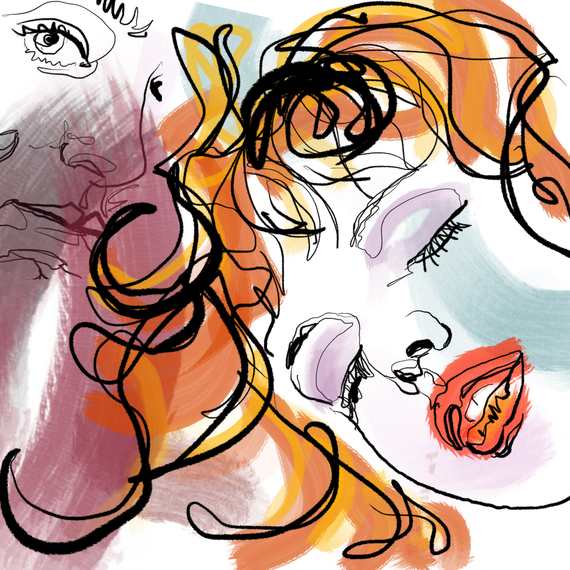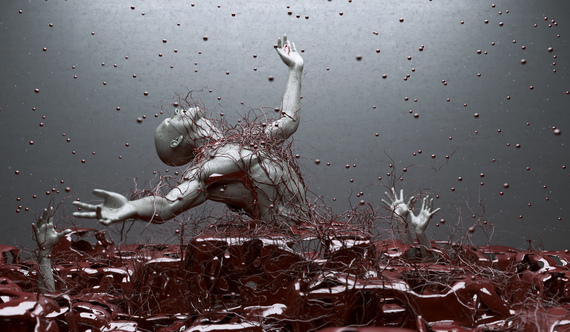Along with a growing number of professional fine artists, digital art has become the core of my own practice and that's why I feel so passionate about becoming an advocate of this fascinating medium. I wouldn't be exaggerating if I said that we've been shouting out for our medium to be fully recognized for some time. Only very recently has the digital medium caught up with more traditional approaches in its ability to be valued seriously by collectors. Up until now, a digital piece of artwork could easily be downloaded copied and shared inconsiderately, making ownership a bit of a sham. Creators of original digital artwork (myself included) have more often than not resorted to creating a physical signed version of the original file so as to achieve a more genuine salable item.
In truth, a digital piece of art can still be copied and shared, however, emerging technology has changed all this radically. A collector can now buy or inherit legal ownership of the original digital artwork and then choose to resell it as it goes up in value. So how has this become possible then? I'll try and explain.
First of all let me clarify what I mean by original digital art in the context of this article. Here I'll focus on original digital art in its pure form, which is made and stored as digitalized data on a computer hardware device. Yes, many artists including myself experiment with a digital medium in order to create a physical outcome in whatever form this might take. Although this is a perfectly valid way of making art, that's not what I'm talking about here.
Digital art in it's pure form, if you like, might be created with anything from an application on a tablet to written code on a computer. Contemporary digital outcomes range from "en plein air" drawings made directly onto touch sensitive screens, to complex multi media pieces that contain both still and moving images as well as sound. LACDA's Rex Bruce, in his 'Curator's Note', has written a more proficient explanation of what digital art can be, in support of the 2016 'Museums and the Web' exhibition.
Of course digitally made art is not that new. Surprisingly, it's been around since the 1960s when one of the first recorded exhibitions of computer generated imagery was put on, not by artists but by scientists at the Howard Wise Gallery in New York. Fifty years later there's still a general assumption, as with the recent digitalization of music, that anything created on a screen with software should be released on the internet to be copied, pasted and downloaded if one likes it. And this has been harming the digital art industry. After all, have we forgotten that it takes as much skill, time and effort to create high quality original digital art piece as it takes to create a traditional oil on canvas? These works have value and deserve recognition. A change in perception of the digital medium is just not enough and the big question still rests over its collectibility.
This is where the emergence of Blockchain technology, offered by businesses such as ascribe, provide a truly innovative solution in securing the provence of a digital file.
Ascribe is a significant new online service that utilizes this new technology empowering "creators to truly own, secure and track the history of a digital work". Being a digital artist, what I find so interesting with this service is that it enables the creator to register artwork using a unique cryptographic ID stored on the blockchain. Ownership of the digital artwork can be passed on through email directly to the buyer or alternatively the rights of transfer can be consigned to a gallery.
Incidentally, one of the newest and most exciting online marketplaces affiliated with ascribe, is called 23VIVI. It's founders, QuHarrison Terry and Ryan Cowdrey, have only just launched their website which I predict will pave the way to the next generation of online digital art collectors. I was sold with the concept right from the beginning and I foresee many other similar platforms following suite in the not to distant future.
As one of the owners puts it, "At 23VIVI we believe we are creating the NASDAQ of digital art, except that our commodities are digital masterpieces and can be visually appreciated for a lifetime."
23VIVI is still a small outfit in comparison to other platforms such as Artfinder, nevertheless they have developed a clever strategy ensuring that one-of-a-kind limited editions of up to 23 are selling out completely! A digital artist can submit their work to 23VIVI. Each edition will have a unique ID that has been stamped into the blockchain, allowing the art to be bought and resold on 23VIVI.
Unlike more traditional media, art work in the form of data generated files, completely removes all the problems involved in storing, presenting, shipping and delivering physical work safely and cost effectively. A creator can define or leave it up to the gallerist or collector as to how the final product is experienced. There are now so many high quality options in the way a digital file can be displayed and most market places offer advice and personal services to help the buyer place and display the work.
In my mind, there can be little doubt over the potential of the digital medium as a major contender in the future of the arts industry. It can't and won't be ignored now that its originality, scarcity and authenticity has been guaranteed.
Follow me and my work by visiting www.adamjamesbutcher.com and sign up to receive an ebook of my recent work.



